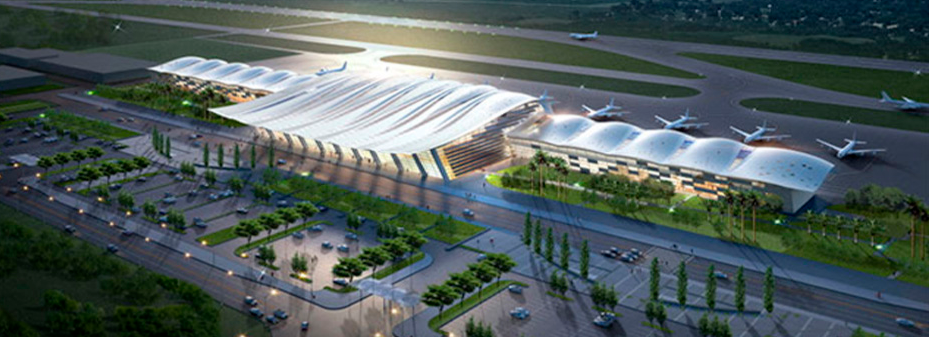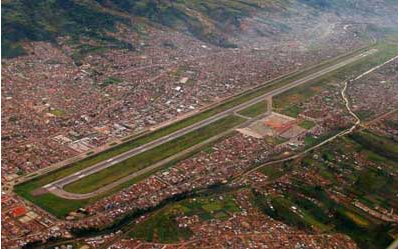By Nicholas Asheshov —
In the 1940s and 1950s, the aborigines of New Guinea, isolated for 45,000 years, began clearing strips of jungle near the tops of their mountains. These clearings would feature great life-sized straw and wooden model airplanes. The clearings and the model planes would attract, according to the local ‘big men’, as they described themselves to the anthropologists, the silvery TWA and Pan Am machines that had begun to appear high in their virgin blue skies. The gringo machines would, the big men predicted, swoop down and land. This would mean more wives, more pigs, more prestige for the big men, the shamans. They would be on Easy St, like the gringos themselves.

The tribesmen would carve earphones, construct straw airport buildings to make their clearings more realistic. Long wavy branches stuck in the ground imitated radio aerials.
Grateful anthropologists call these millenarian beliefs Cargo Cults.
In Cusco the Chinchero airport is, in the same way, a cargo cult. It has its place in local folklore, for sure. But it has no connection with economic reality. It aims, gratuitously, to destroy an ancient locality, one of the remaining magical districts of a favored region of South America. It should be under United Nations protection
The Cusqueños, led by the Chamber of Commerce and the Regional government, are trying the same as the ancient cultures of New Guinea aborigenes. The Cusqueños have for decades believed, with religious fervor, that if they construct a huge airport, even if it is dangerous and not needed, in the thin, blustery, foggy, thunderstorm mountains of Chinchero, they will gain prestige, become big men, just like the folks in Lima.

Waves of Airbuses and Boeings will not flock into Chinchero ‘International,’ supposing this billion-dollar disaster should creep off the drawing board into confused reality. The $530mn sticker price is already long out of date, as are the skimpy, unverified, half-baked engineering studies, and will of course triple: this third-world deal is a legacy of the uncontrolled Humala government.
The Chinchero airport is plagued by local corruption, being investigated, we can at least hope, by the Comptroller in Lima. The contractor, Kunturwasi and Andina Holdings, are junk-rated on the financial markets — a Lima airport French-managed hotel scheme has come to nothing. Their Paita port concession has collapsed. They have no capital and less credit.
Chinchero would bring no benefit to most people in Cusco. If the government wants, as it has every right, to put money into Cusco, there are a dozen better ways of spending the money. It would go on projects that are long needed, much more useful to the population at large.
Plus, the Chinchero figures do not remotely add up. The other day, for instance, Vice President Martin Vizcarra said the Chinchero airport would bring in $100mn a year and offered to cut Cusco in, for free, for one-third of this. It would be additional income for the Region. Another third would go, the VP said, to fatten the Peruvian budget.
This kind of fantasy is par for the course, social anthropologists say, of the cargo cult millenium formula. The academic technical texts refer to this as the Concord Syndrome, whose headline caption is: “If we throw another $10 billion at it, it will fly.” Half a century ago the British and French governments got together to build the supersonic Concord, “the best plane ever built to fly halfway across the Atlantic,” as the Americans called it. Another cargo cult prophecy came from President Kuczynski, using figures fed to him by the Ministry of Tourism, run by Cuzqueños, that Chinchero would be receiving seven million tourists.
Here are the real numbers.
Last year, 2016, Machu Picchu entry tickets numbered 1,325,000. In round numbers these were nearly one million foreigners, the rest, one-third, were Peruvians, an encouraging increase from the under-10% of the much smaller numbers of visitors in the 1990s.
The 2016 figure is already, at 7,000+ visitors a day during the high season, three times more than the United Nations top permitted figure of 2,200/day. Averaged out with the low season, last year the number of visitors was 3,900/day, in itself 60% higher than the UN maximum figure.
A visit today to Machu Picchu features long queues, constant pushing along roped paths, raucous shouts from guides, piercing whistles from guards. Not much calm Inca reflection time. A visit to the loo means fighting back against dense streams of other tourists.
The message to the Chinchero cargo cult and to the folks in Lima is: Machu Picchu is already full. It cannot take more airplane loads. It does not need, cannot take another airport.
The Ministry of Culture and the Ministry of Tourism have had plans to use better the whole area of the Machu Picchu Park complex. This would in theory allow a few more paying customers as well as, in general, an upgrade in service, much needed. Tourists would be limited to either morning or afternoon tickets. Slicing and dicing this might allow, officials say, a sustainable, not unpleasant 7,000 tourists a day. You might even have quiet night visits, when hundreds of friendly vizcachas-chinchillas sport through the terraces and deserted temples. Call it a bit over 2 mn per year, tops. We’re already almost there. Machu Picchu cannot take another airstrip, let alone a fancy billion-dollar boondoggle.
The other key figure, talking of Chinchero, is that between 35% and 40% of visitors to Machu Picchu travel already to and from Cusco by land, braving the poorly, potholed roads up from Nazca and through Cusco to Puno.
Cusco has to provide 1.4 mn, no more, tourists with airport capacity during the year. That’s it. It is not 4mn or 7mn tourists for Cusco. This assumes the obvious, that every tourist coming to Cusco will demand, naturally enough, to spend at least half a day at Machu Picchu. They may spend a week, a month or more seeing the many other attractions of Cusco. But however long they stay, they need only one in/out ticket at the airport. The rest prefer, rightly, to come and go by land, see the country.
Then there is the local traffic of residents and business people, which will grow by a few points a year, like everywhere else. But the ones who pay the piper are the tourists. Ask the airlines, the hotels.

The Machu Picchu restriction, MPR, means only 1,000 more airborne tourists a day. No more. That’s just half a dozen more flights than today. This can best be handled by $40mn worth of upgrades to the present Velasco Astete airport, which has plenty of room, 240 hectares of good flat land. With redesigned terminals, runways and electronics it will do the job indefinitely. The only reason to change it is because the Cusco Big Men want this downtown land to turn it into apartments and offices. As Roger Valencia, the Vice Minister of Tourism and Cusco’s top guide puts it, “urban renewal.”
The present airport is good through 2037. Because of the MPR. The correct strategy for Cusco is not to try to bring in more tourists but to encourage the ones who do come to stay longer, spend more.
Big Men aside, all Cusqueños would prefer something along the following lines.
- Scrap the twisted Kunturwasi contract. Replace it with new engineering and financial studies to determine where and when a new airport might be needed. The present ones were done by Spaniards, the same ones who engineered the famous multi- zillion euro airstrip in Murcia which a decade on, still has no traffic. Better options than Chinchero include Occoruro, south of Cusco on unused pampa from where a fast light railway link would get passengers to and from Cusco faster than they would from the crowded Chinchero access. Occoruro is the same height above sea level as Chinchero. Not good, but no worse and one-quarter to one-third the cost of Chinchero.
- The Pampa de Anta between Chinchero and Cusco, is the same height as the present airport, much lower and therefore better, also flatter than Chinchero.
- Fund a $250mn list of road, health, education, and river cleanup projects. Cusco has lousy roads, bad pollution and traffic, no more water. A fancy airport will benefit a tiny number of people. Best clean up Cusco first, to benefit hundreds of thousands of people, not just the cargo cult lobby.
There is a solution to the Cusco airport problem. But it does not include building a dangerous, destructive, un-needed and un-wanted airstrip at 3,800m a.s.l. on the lovely, traditional fields, the colonial church, and the Inca ruins that the government should be defending, not destroying.
________
This article was published in Spanish in Caretas magazine this week.
Nick Asheshov was editor of the Andean Air Mail & Peruvian Times during the 1970s and 1980s, and of The South Pacific Mail, Santiago during the 1990s. He was Latin America Editor of Institutional Investor, New York over the same period. He lives in Urubamba, where he writes a blog and where he has been prominent in the hotel and railway business.
Asheshov wrote an earlier article on the Chinchero airport project, published Jan.26, 2017 : Lost in the Clouds of Poor Engineering and Bad Finance






Well said in all respects. But I would further suggest that Cusco itself is reaching, or perhaps has already reached, the limit of its non-destructive exploitability, and, for starters, all Macchu Pichu access fees, including for national and foreign tourists, and for all collateral or related businesses, such as hotels and restaurants, all modes of transport, and tourism agencies, should be substantially increased and set at a level that can meet all reasonably required services aimed at local residents and tourists including but not limited, of course, to maintenance and repairs for historical sites and all manner of access routes. However magic or surreal the Citadel may appear to be, it can and will suffer grievous damage if the current avalanche of visitors contiunes unabated, and so will the Capital of the Inca Empire. I could, of course, be wrong.
As a tourist (french) in the Cuzco area last march, it seems very obvious that it’s not a good idea at all to build an airport in Chinchero. The village and the land are so beautiful. Like the whole Cusco area. As you write it, there are many things to see, not only the Machu Picchu (which disappointed me a bit, considering the crowd). Tourists should stay longer in the area, and not only visit the Machu Picchu.
Another point to consider is the saturation of the road leading to the Machu Picchu, in particular in the beautiful Ollantaytambo. In this village, like in other ones in the area, it would be more interesting for the inhabitants that tourists stay, rather than more tourists go through.
Another point to consider is the impact of the pollution air traffic for the direct environment in Cusco (mountains, glaciers). You can watch “Abismo climatico” which was shown in “La noche del cortometraje Cusqueño 2017”, about this.
https:// vimeo. com/202816058
To destroy the inca culture in Peru and of south america would be a very big mistake, including the tourism…
I’ve noticed that most opponents to the Chinchero airport fall in one of three groups:
1. People connected to LAN/LATAM, the airline that serves the Lima-Cusco route and stands to lose dearly if a new intl airport is built nearby Cusco.
2. Supporters of former president Fujimori (now in jail for corruption and egregious human rights abuses) and his daughter, who has every intention of running for president yet again in 2021. The Fujimori crowd despise the idea that the current administration will take all the credit for this new airport.
3. Lastly, many who oppose the airport own land in Anta or other alternative locations that are allegedly “better” than Chinchero, and therefore, are looking after their own interests.
Of course, there are other types of airport opponents, mainly environmentalists and socialists who would oppose nearly any new airport anywhere.